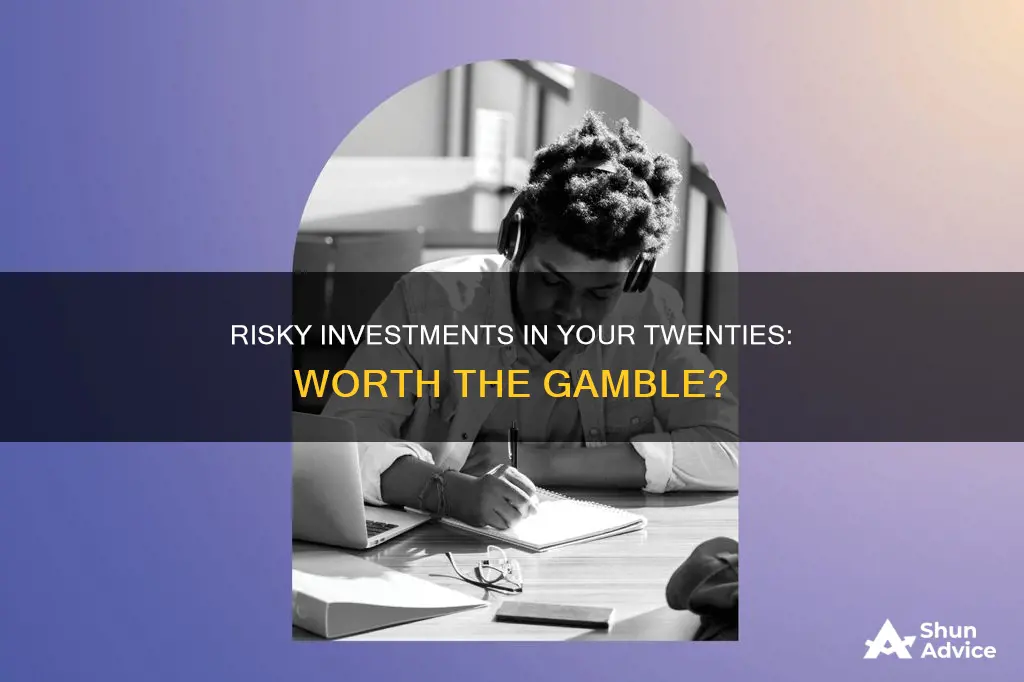
Investing is a great way to build wealth, and for those in their twenties, it can be a powerful tool to secure their financial future. While investing is generally recommended, there is a question that often arises: should young investors take on more risk? This decision is a crucial aspect of financial planning and can have a significant impact on long-term gains.
Some experts argue that taking on more risk can be beneficial for younger investors. This is because they have a longer time horizon, allowing their investments to recover from potential downturns. Additionally, younger investors may have less income to invest, so taking calculated risks can help them achieve higher returns. However, it's important to remember that investing in the stock market or other volatile assets is not the same as gambling.
| Characteristics | Values |
|---|---|
| Risk tolerance | Younger investors can tolerate more risk |
| Income | Younger investors have less income to invest |
| Time | Younger investors have more time to recover from losses |
| Investment type | Younger investors can seek out bigger returns by taking bigger risks |
What You'll Learn

Young investors can take on more risk
Young investors are in a unique position to take on more risk. While it may seem counterintuitive, there are several reasons why this is the case.
Firstly, younger investors have time on their side. Compounding is a powerful force in investing, and the earlier one starts, the more time their money has to grow. For example, if an individual starts investing at 25, they can become a millionaire by 60 while investing only half as much annually as someone who starts at 35. This is due to the effects of compound interest, which can significantly increase the value of an investment over time.
Secondly, young investors can seek out bigger returns by taking calculated risks. If a young investor loses money, they have the advantage of time to recover those losses through income generation. This doesn't mean they should gamble or engage in highly speculative trades. Instead, they should focus on investing in companies with higher risk but greater upside potential over the long term. Small-cap stocks, for instance, are a segment of the stock market that tends to be riskier but also offers higher returns. These are typically smaller, less established companies, some of which go on to become major players in their industries.
It's important to note that taking on more risk doesn't mean abandoning all caution. Young investors should still conduct thorough research and avoid deals that seem too good to be true. Leveraging tools like index funds or exchange-traded funds (ETFs) can help diversify their investments and reduce risk.
Additionally, young investors should make use of tax-advantaged retirement accounts, such as 401(k)s or Roth IRAs, to maximize their investments over the long term. By starting early and taking advantage of compound interest, they can build a substantial nest egg for retirement.
Finally, young investors should not procrastinate. The stock market has historically trended upwards, and getting an early start can help them take advantage of this tendency. By investing regularly and incrementally increasing their savings rate, they can build a solid financial foundation for the future.
Streamline Your Parking: Invest in Smart Management Solutions
You may want to see also

The benefits of investing early
Investing early in your life, especially in your twenties, has several benefits. Here are some of the key advantages:
Compounding returns
Compounding is a powerful force in investing. When you invest early, your money has more time to grow and benefit from compounding returns. For example, if you start investing at 25, you can become a millionaire by 60 with half the annual investment of someone who starts at 35. The power of compounding allows your investments to generate returns, and those returns are reinvested to generate further returns. Over time, this exponential growth can lead to a substantial portfolio value.
Higher risk tolerance
Young investors can typically tolerate more risk. If you invest in your twenties, you have the advantage of time to recover from any potential losses. This enables you to seek higher returns by taking calculated risks. While it's not advisable to gamble or speculate, investing in companies with higher risk but greater upside potential over the long term can pay off. Small-cap stocks, which are shares of smaller, less established companies, are one such option. While some of these companies may not succeed, others can become highly valuable over time.
Building a solid financial foundation
Starting to invest early in life helps you build a solid financial foundation for the future. It encourages good money habits, such as saving and investing instead of spending all your income. Additionally, investing early can increase your wealth and improve your quality of life in both the short and long term. By the time you reach your thirties, you will have already established a solid investment portfolio and be well on your way to achieving your financial goals.
Taking advantage of employer matches
Many employers offer 401(k) plans that match your contributions up to a certain percentage of your salary. By investing early in your twenties, you can take full advantage of these employer matches and boost your retirement savings significantly. For example, if your employer matches half of your 401(k) contributions up to 6% of your salary, starting at age 22 can lead to over $1.2 million by age 65, assuming a 7% return and annual salary increases. Without the employer match, you would have only $800,000.
Long-term focus
Investing in your twenties allows you to focus on the long term. Short-term market fluctuations become less concerning when you have a longer time horizon. This enables you to ride out market downturns and focus on your long-term investment strategy. Additionally, you can take advantage of dollar-cost averaging, investing a fixed amount at regular intervals, which helps smooth out the impact of market volatility.
Strategies for Investment Managers to Outperform Benchmarks
You may want to see also

The pros and cons of aggressive investing
When it comes to investing, there are various strategies that individuals can adopt, depending on their risk appetite, financial goals, and life stage. One such strategy is aggressive investing, which typically involves taking on more risk in pursuit of higher returns. Here are some pros and cons of aggressive investing to consider:
Pros of Aggressive Investing:
- Potential for Higher Returns: Aggressive investing typically involves allocating a larger portion of one's portfolio to stocks or other risky assets. These investments tend to offer higher potential returns compared to more conservative options like bonds or money market funds. Over the long term, these higher returns can compound and lead to significant wealth accumulation.
- Suitability for Long-Term Goals: Aggressive investing is often aligned with long-term financial goals, such as retirement. Younger investors have a longer time horizon, allowing them to ride out market fluctuations and recover from potential losses. This makes aggressive investing more suitable for those with decades until retirement.
- Risk Tolerance: Age plays a crucial factor in risk tolerance. Younger investors tend to have a higher risk tolerance since they have more time to recover from potential losses. This makes them better positioned to take on the risks associated with aggressive investing strategies.
Cons of Aggressive Investing:
- Increased Risk: The most significant drawback of aggressive investing is the heightened risk. By allocating a larger portion of one's portfolio to risky assets, the potential for significant losses increases. Market downturns or individual stock declines can result in substantial negative returns, which may take a considerable time to recover from.
- Volatility: Aggressive investment portfolios tend to be more volatile due to the higher allocation of risky assets. This volatility can be unnerving for investors, especially those who are risk-averse or approaching retirement. It may lead to emotional decisions, such as selling at market lows, further exacerbating losses.
- Psychological Impact: While younger investors can recover from financial losses over time, the psychological impact of those losses can be significant. A large loss early in one's investing journey can scar an investor, affecting their future choices and potentially leading to an aversion to risk or investing altogether.
In conclusion, aggressive investing can be a viable strategy for younger individuals with a long investment horizon and a higher risk tolerance. However, it is essential to carefully consider the increased risks and potential drawbacks before adopting this strategy. Diversification, regular portfolio rebalancing, and a long-term focus can help mitigate some of the risks associated with aggressive investing.
Savings vs Investments: Macroeconomics' Distinct Financial Strategies
You may want to see also

The importance of a long-term time horizon
When it comes to investing, particularly for those in their twenties, a long-term time horizon is crucial. This is because a longer time horizon allows for greater potential growth and provides a buffer against short-term market fluctuations. Here's why this is so important:
Compounding Effects:
Compounding is a powerful force in investing. The earlier you start, the more time your investments have to grow and the larger your returns can be. For example, if you start investing at 25, you can become a millionaire by 60 with only half the annual investment of someone who starts at 35. This is because the power of compounding amplifies the effects of time, allowing your money to make more money over a longer period.
Riding Market Waves:
Stock markets tend to rise over the long term, but this growth is not linear. There will be years or stretches of years where the market declines. By having a long-term horizon, you can ride out these temporary downturns and benefit from the market's overall upward trend. This is especially important if you're investing in riskier assets, as they tend to be more volatile but also offer higher potential returns.
Recovery from Losses:
When you're young, you have the advantage of time to recover from any investment losses. If you take calculated risks and they don't pay off, you have the ability to recoup those losses through future income generation. This is not the case for older investors, who are closer to retirement and may not have the same earning potential.
Risk Tolerance:
Your age plays a significant role in determining your risk tolerance. Younger investors can generally afford to take on more risk because they have a longer time horizon. This means you can seek out bigger returns by investing in riskier assets or using leverage, although this should be done cautiously. A long-term horizon gives you the flexibility to recover from potential losses and build a substantial portfolio over time.
Building Wealth:
Investing when you're young is not just about retirement planning. It's also about increasing your wealth and improving your quality of life in the short term. By investing instead of spending all your money, you can build a solid financial foundation that will benefit you throughout your life.
In summary, a long-term time horizon is crucial when considering risky investments in your twenties. It allows for compounding growth, provides a buffer against market volatility, enables recovery from losses, aligns with your risk tolerance, and sets you up for building wealth over time. This approach can help you maximize the benefits of investing and set you on a path towards financial success.
Clo Managers: Investing in Their Own Success?
You may want to see also

How to balance risk and reward
When it comes to investing, there is no one-size-fits-all approach, and the level of risk one takes should be tailored to their specific circumstances and risk tolerance. That said, there are some general principles to consider when balancing risk and reward, especially for individuals in their twenties.
Firstly, it's important to understand the concept of an investment portfolio and the different types of investments it can include. An investment portfolio can consist of various financial instruments such as money market funds, bonds, stocks, and more. Each type of investment has a different level of risk and potential return. For example, stocks are generally considered riskier than money market funds or bonds, as they tie the investor's results to the performance of a single company.
When deciding how to allocate their investments, individuals in their twenties should consider their risk tolerance and investment goals. A conservative investment portfolio is typically weighted more towards bonds and money market funds, offering lower potential returns but also lower risk. This type of portfolio may be suitable for those who are closer to retirement or who are more afraid of losing money than not making enough. On the other hand, an aggressive investment portfolio is weighted more towards stocks, offering the potential for higher returns but also carrying a higher level of risk. This type of portfolio may be suitable for investors who are comfortable with market volatility and have a long-term investment horizon.
It's worth noting that younger investors tend to have a higher risk tolerance since they have more time to recover from potential losses. As such, they can seek bigger returns by taking calculated risks. However, this doesn't mean gambling or making highly speculative trades. Instead, young investors should focus on investing in companies with higher risk but greater upside potential over the long term, such as small-cap stocks. By investing in a diversified portfolio or index fund, they can mitigate some of the risks associated with individual stocks.
Additionally, young investors should be mindful of the power of compound interest. Starting to invest early and taking advantage of the tendency for stock prices to rise over time can lead to significant wealth accumulation down the road. For example, an individual who starts investing at 25 can become a millionaire at 60 by investing half as much each year as someone who starts at 35.
Finally, it's crucial for young investors to educate themselves and ask questions before making investment decisions. Seeking the advice of a financial advisor or conducting thorough research can help young investors make informed choices that align with their risk tolerance and investment goals.
Equity-Equivalent Investment: Understanding This Innovative Funding Option
You may want to see also
Frequently asked questions
It depends on your risk tolerance and investment goals. Generally, younger investors can take on more risk due to their longer investment horizon, but it's important to weigh the potential rewards against the possibility of losses.
Younger investors tend to have more time to recover from potential losses and can seek bigger returns by taking calculated risks. Compounding returns over time can also lead to significant growth in your portfolio.
Taking on excessive risk can lead to significant losses that may discourage you from investing or impact your future investment choices. It's important to understand your risk tolerance and invest within your comfort level.
Consider your financial goals, risk tolerance, and time horizon. Diversification and asset allocation are essential to managing risk. Consult with a financial advisor or conduct thorough research to make informed decisions.







